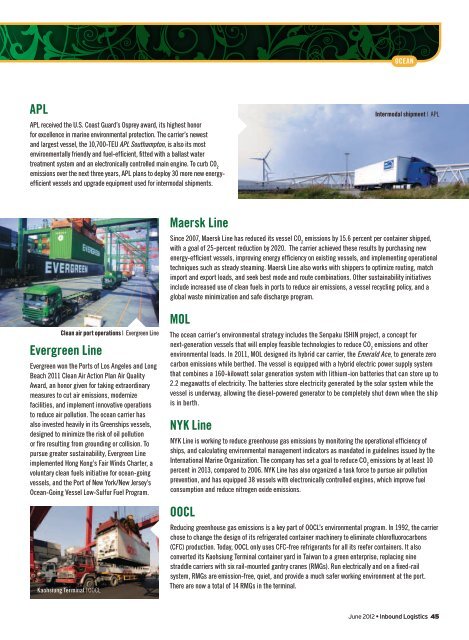75 GREEN SUPPLY CHAIN PARTNERS
75 GREEN SUPPLY CHAIN PARTNERS
75 GREEN SUPPLY CHAIN PARTNERS
You also want an ePaper? Increase the reach of your titles
YUMPU automatically turns print PDFs into web optimized ePapers that Google loves.
APL<br />
APL received the U.S. Coast Guard’s Osprey award, its highest honor<br />
for excellence in marine environmental protection. The carrier’s newest<br />
and largest vessel, the 10,700-TEU APL Southampton, is also its most<br />
environmentally friendly and fuel-effi cient, fi tted with a ballast water<br />
treatment system and an electronically controlled main engine. To curb C0 2<br />
emissions over the next three years, APL plans to deploy 30 more new energyeffi<br />
cient vessels and upgrade equipment used for intermodal shipments.<br />
Clean air port operations | Evergreen Line<br />
Evergreen Line<br />
Evergreen won the Ports of Los Angeles and Long<br />
Beach 2011 Clean Air Action Plan Air Quality<br />
Award, an honor given for taking extraordinary<br />
measures to cut air emissions, modernize<br />
facilities, and implement innovative operations<br />
to reduce air pollution. The ocean carrier has<br />
also invested heavily in its Greenships vessels,<br />
designed to minimize the risk of oil pollution<br />
or fi re resulting from grounding or collision. To<br />
pursue greater sustainability, Evergreen Line<br />
implemented Hong Kong’s Fair Winds Charter, a<br />
voluntary clean fuels initiative for ocean-going<br />
vessels, and the Port of New York/New Jersey’s<br />
Ocean-Going Vessel Low-Sulfur Fuel Program.<br />
Kaohsiung Terminal | OOCL<br />
Maersk Line<br />
OCEAN<br />
Since 2007, Maersk Line has reduced its vessel CO 2 emissions by 15.6 percent per container shipped,<br />
with a goal of 25-percent reduction by 2020. The carrier achieved these results by purchasing new<br />
energy-effi cient vessels, improving energy effi ciency on existing vessels, and implementing operational<br />
techniques such as steady steaming. Maersk Line also works with shippers to optimize routing, match<br />
import and export loads, and seek best mode and route combinations. Other sustainability initiatives<br />
include increased use of clean fuels in ports to reduce air emissions, a vessel recycling policy, and a<br />
global waste minimization and safe discharge program.<br />
MOL<br />
The ocean carrier’s environmental strategy includes the Senpaku ISHIN project, a concept for<br />
next-generation vessels that will employ feasible technologies to reduce CO 2 emissions and other<br />
environmental loads. In 2011, MOL designed its hybrid car carrier, the Emerald Ace, to generate zero<br />
carbon emissions while berthed. The vessel is equipped with a hybrid electric power supply system<br />
that combines a 160-kilowatt solar generation system with lithium-ion batteries that can store up to<br />
2.2 megawatts of electricity. The batteries store electricity generated by the solar system while the<br />
vessel is underway, allowing the diesel-powered generator to be completely shut down when the ship<br />
is in berth.<br />
NYK Line<br />
NYK Line is working to reduce greenhouse gas emissions by monitoring the operational effi ciency of<br />
ships, and calculating environmental management indicators as mandated in guidelines issued by the<br />
International Marine Organization. The company has set a goal to reduce CO 2 emissions by at least 10<br />
percent in 2013, compared to 2006. NYK Line has also organized a task force to pursue air pollution<br />
prevention, and has equipped 38 vessels with electronically controlled engines, which improve fuel<br />
consumption and reduce nitrogen oxide emissions.<br />
OOCL<br />
Intermodal shipment | APL<br />
Reducing greenhouse gas emissions is a key part of OOCL’s environmental program. In 1992, the carrier<br />
chose to change the design of its refrigerated container machinery to eliminate chlorofl uorocarbons<br />
(CFC) production. Today, OOCL only uses CFC-free refrigerants for all its reefer containers. It also<br />
converted its Kaohsiung Terminal container yard in Taiwan to a green enterprise, replacing nine<br />
straddle carriers with six rail-mounted gantry cranes (RMGs). Run electrically and on a fi xed-rail<br />
system, RMGs are emission-free, quiet, and provide a much safer working environment at the port.<br />
There are now a total of 14 RMGs in the terminal.<br />
June 2012 • Inbound Logistics 45


